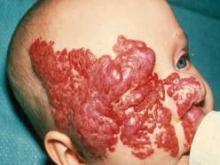Inpatient hospitalization is recommended for infants with hemangiomas who are undergoing treatment with propanolol if they are younger than 8 weeks of gestational age, have inadequate social support, or have a comorbid condition affecting the cardiovascular or respiratory system, according to new consensus guidelines on the use of propranolol.
Outpatient initiation with monitoring can be considered for infants older than 8 weeks of age who have adequate social support and who do not have significant comorbidities, noted Dr. Ilona J. Frieden, who presented an overview of the soon-to-be published guidelines at the Women’s and Pediatric Dermatology Seminar, sponsored by Skin Disease Education Foundation (SDEF).
Dr. Frieden was part of a multispecialty consensus group of experts who met in December 2011 to draft the recommendations on when to admit patients for hospitalization and which patients should be considered for outpatient therapy.
The guidelines also emphasize that all patients who receive propranolol should be monitored with heart rate and blood pressure measurements at baseline and at 1 and 2 hours after receiving the initial dose.
"Clinicians should repeat these measurements with dose increases greater than 0.5 mg/kg per day, including at least one set of measurements after the target dose has been achieved," said Dr. Frieden, professor of dermatology and pediatrics at the University of California, San Francisco. "If heart rate and blood pressure are abnormal, the child should be monitored until the vital signs normalize."
According to Dr. Frieden, the guidelines do not recommend routine glucose testing. "The risk of hypoglycemia is age dependent and begins after 8 hours of fasting in children 0-2 years of age," she said. The guidelines recommend that infants younger than 6 weeks of age be fed every 4 hours, those 6 weeks to 4 months of age every 5 hours, and those older than 4 months every 6-8 hours. They also state that propranolol should be discontinued during intercurrent illness, especially in the setting of restricted oral intake.
"These recommendations are based on current knowledge and should be considered subject to revision," Dr. Frieden said.
The efficacy of propranolol as a treatment for infantile hemangiomas is well documented, but its mechanism of action is not yet fully understood. "We don’t know why it works," she said.
Current hypotheses suggest that propranolol may decrease renin production, inhibit angiogenesis via vascular endothelial growth factor, or induce of apoptosis in microvascular endothelial cells.
A recent systematic review of 41 studies involving 1,264 patients who received beta blockers for infantile hemangiomas found that 28% of patients received prior medical therapy, most commonly oral prednisone. The review, which was reported during a poster session at the 2012 meeting of the Society for Pediatric Dermatology, found that propranolol was initiated at a mean age of 6.6 months with a mean dose of 2.1 mg/kg per day for a mean duration of 6.4 months.
The mean response rate was 98%, with a range between 82% and 100%. "Response measurements varied, but response rates were comparable irrespective of the anatomic site where the hemangioma was located," Dr. Frieden said.
Rebound growth occurred in 17% of cases and the adverse event rate ranged from 3% to 5%, most commonly sleep changes and acrocyanosis. Serious adverse events were rare.
Dr. Frieden disclosed that she has consulted for Pierre Fabre, which is developing propranolol as a treatment for infantile hemangiomas. SDEF and this news organization are owned by Frontline Medical Communications.



